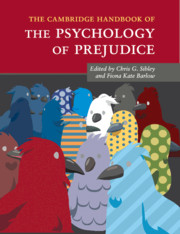Book contents
- Frontmatter
- Dedication
- Contents
- List of Figures
- List of Tables
- Notes on the Contributors
- Part I General Theoretical Perspectives
- 1 An Introduction to the Psychology of Prejudice
- 2 Evolutionary Approaches to Stereotyping and Prejudice
- 3 From Prejudice to Social Change: A Social Identity Perspective
- 4 Ingroup Projection as a Challenge of Diversity: Consensus about and Complexity of Superordinate Categories
- 5 Intergroup Discrimination: Ingroup Love or Outgroup Hate?
- 6 Intergroup Emotions Theory: Prejudice and Differentiated Emotional Reactions toward Outgroups
- 7 Intergroup Threats
- 8 Social Dominance Theory: Explorations in the Psychology of Oppression
- 9 The Dual Process Motivational Model of Ideology and Prejudice
- 10 Is Prejudice Heritable? Evidence from Twin Studies
- Part II Prejudice in Specific Domains
- Part III Prejudice Reduction and Analysis in Applied Contexts
- Index
- References
10 - Is Prejudice Heritable? Evidence from Twin Studies
from Part I - General Theoretical Perspectives
Published online by Cambridge University Press: 17 November 2016
- Frontmatter
- Dedication
- Contents
- List of Figures
- List of Tables
- Notes on the Contributors
- Part I General Theoretical Perspectives
- 1 An Introduction to the Psychology of Prejudice
- 2 Evolutionary Approaches to Stereotyping and Prejudice
- 3 From Prejudice to Social Change: A Social Identity Perspective
- 4 Ingroup Projection as a Challenge of Diversity: Consensus about and Complexity of Superordinate Categories
- 5 Intergroup Discrimination: Ingroup Love or Outgroup Hate?
- 6 Intergroup Emotions Theory: Prejudice and Differentiated Emotional Reactions toward Outgroups
- 7 Intergroup Threats
- 8 Social Dominance Theory: Explorations in the Psychology of Oppression
- 9 The Dual Process Motivational Model of Ideology and Prejudice
- 10 Is Prejudice Heritable? Evidence from Twin Studies
- Part II Prejudice in Specific Domains
- Part III Prejudice Reduction and Analysis in Applied Contexts
- Index
- References
Summary
The idea of studying prejudice from a genetic standpoint may at first strike some as inappropriate. Genetic explanations of human emotion, thought, and behavior have often been used to justify prejudice, rather than explain it. Following the 1859 publication of Charles Darwin's theory of evolution in which he explained the change of traits over generations in both animal and plant species, Francis Galton aimed to apply evolutionary principles to human populations (Paul & Hasian, 1998). In 1883, Galton coined the term “eugenics” to describe the science of increasing the prevalence of desired traits within a population through selective breeding. While his ideas were initially challenged, they gained popularity in the early twentieth century, and multiple university departments began officially studying eugenics. Simultaneously, societies sprang up aiming to promote breeding in those of “high genetic quality” and supporting the forced sterilization of those of “low genetic quality” such as the mentally ill (Paul & Hasian, 1998).
By the 1930s, the most famous proponent of eugenics, Adolf Hitler, was rising to power. While some in England and America supported his aims and the principles of eugenics, many others were beginning to express concern about the use and validity of a eugenic approach. In the quote that follows, famed behavioral psychologist John Watson argued against a genetic understanding of human behavior. He posited that with enough resources, he would be able to make of a child what he chose, regardless of any “tendencies” that child might have:
Give me a dozen healthy infants, well-formed, and my own specified world to bring them up in and I'll guarantee to take any one at random and train him to become any type of specialist I might select – doctor, lawyer, artist, merchant-chief and, yes, even beggar-man and thief, regardless of his talents, penchants, tendencies, abilities, vocations, and race of his ancestors.
(Watson, 1930, p. 82)Vitally, in the last sentence, Watson challenged racist assumptions of his time to state that he could achieve these goals irrespective of a child's race. Through their research, Watson and his contemporaries unequivocally demonstrated that there are large environmental impacts on the way that we behave. It is possible, however, that Watson's comments (and even research) were also political.
- Type
- Chapter
- Information
- The Cambridge Handbook of the Psychology of Prejudice , pp. 222 - 238Publisher: Cambridge University PressPrint publication year: 2016
References
- 2
- Cited by



